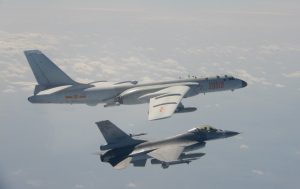In my column for The Diplomat last week, I looked at China’s military activities and resultant confrontation with its Southeast Asian neighbors, Indonesia and Vietnam. Despite the Indo-Pacific region reeling under the coronavirus pandemic, the People’s Liberation Army (PLA) has been active farther east as well. There have been reports of several Chinese naval and air intrusions in Taiwan and Japan.
Back in the first half of February, the PLA Eastern Theater Command started sending its fighter jets and bombers around Taiwan. In response, Taiwan’s Air Force had to scramble its own fighters to shadow the Chinese aircraft. On February 10, Chinese jets reportedly briefly crossed “an unofficial middle line in the Taiwan Strait.” The same day, the PLA Eastern Theater Command stated that its military has been engaged in “air-ground assault and fire support drills to further refine and test their multi-service joint combat capabilities.” Further, Zhang Chunhui, Air Force spokesman of the PLA Eastern Theater, said that “following the February 9 sea-air combat readiness cruise, the theater forces organized a joint exercise of sea and air forces in the sea area of southeastern Taiwan on February 10, mainly carrying out air-ground assault, firepower support and other actual combat training, further tempering and testing the joint combat capabilities of multiple arms in the theater.”
Taiwan’s Ministry of Foreign Affairs in a tweet asked Beijing to stop threatening Taiwan militarily, and instead focus on the coronavirus. Taiwan’s Mainland Affairs Council (MAC) in a statement affirmed that “provocations by PLA warships and planes which have frequented the vicinity of the Taiwan Strait in recent years to seek unification through military force gravely undermine the status quo in the Taiwan Strait and heighten regional tensions.” Commenting on the situation, U.S. Assistant Secretary of State for Political-Military Affairs R. Clarke Cooper said, “It was completely inappropriate of China to take such an aggressive act.” Elaborating on the impact on the security of the Indo-Pacific, Cooper said that “there should be responsible behavior to make sure that the region is free and open — not just for navigation but also for trade and for relationships. Such coercive, aggressive behavior is counter to having a free and open Indo-Pacific region.”
The PLA’s air intrusions continued in March and April as well. In mid-March, Taiwan’s Ministry of Defense stated that they had to respond to Chinese J-11 fighters and KJ-500 airborne early warning and control aircraft, which flew into the waters southwest of Taiwan conducting night-time exercises. This was possibly the first time that they were engaged in a night-time drill near Taiwan. The Ministry also said that these aircraft had come close to Taiwan’s Air Defense Identification Zone. The Ministry added that “After our air reconnaissance and patrol aircraft responded appropriately, and broadcast (an order) to drive them away, the communist aircraft flew away from our Air Defense Identification Zone.” Toward the end of March, Taiwan’s Defense Ministry claimed that there were as many as four “targeted” drills by China around Taiwan, which Taipei considered as “concrete evidence of provocations and threats.” In response, Taiwan conducted its own exercise, deploying its F-16 fighter jets. The PLA Daily reportedly said that the Eastern Theater Command responsible for Taiwan had carried out long-endurance training with its early-warning aircraft lasting for 36 hours.
Tensions between China and Taiwan are not new. Friction has been increasingly evident since Taiwan President Tsai Ing-wen came to power in 2016 and her re-election in January has served to further increase tensions. Put simply: Beijing fears that Tsai will encourage pro-independence forces in Taiwan.
Meanwhile, in mid-April, China’s aircraft carrier Liaoning and five other warships were reportedly sighted sailing past Taiwan waters and through the Miyako Strait. A Japanese Ministry of Defense official, who spoke on the condition of anonymity, said that they tracked the Chinese aircraft carrier, two guided missile destroyers, two multirole warships, and one supply-class fast combat support ship. Citing Taiwan’s Ministry of Defense statement, the report said that the Taiwanese navy, too, had sent its ships to monitor the carrier strike group as it sailed east of Taiwan. Taiwan’s vice defense minister, Chang Guan-chung, stated in parliament that when the pandemic was spreading worldwide, “if the Chinese Communists attempted to make any military adventure leading to regional conflict, they would be condemned by the world, and regardless of what would happen, we are all ready and have made the best preparation for this.”
Currently, the Chinese aircraft carrier is the only one in the area. Two U.S. carriers, Theodore Roosevelt and Ronald Reagan, are in port. The Theodore Roosevelt is now in Guam, on account of an outbreak of coronavirus cases among the crew, and the Ronald Reagan is in Yokosuka Naval Base for maintenance. However, the increase in PLA military activities in the Taiwanese waters and airspace have spurred greater U.S. military engagements as well. It has been reported that a U.S. Navy EP-3 reconnaissance plane was sighted close to Taiwanese airspace near Kaohsiung. Increased military drills of such kinds could potentially lead to unintended mishaps. The EP-3 spy plane incident in April 2001 should be a useful reminder regarding the kind of mishaps that can happen. China’s military moves in the region, despite the pandemic, are only likely to generate fear in the region and inspire greater cooperation with Washington.
































